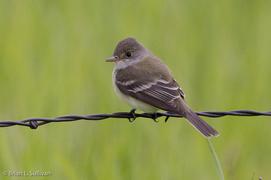WILLOW FLYCATCHER MO-153
Prairie State Park, Mindenmines, Missouri
June 2, 7:53 a.m.
Sunrise at 5:58 a.m.
About 10 yards away, just across a bubbling brook and sitting in plain view in a dead twig atop a small maple, sings a willow flycatcher. It's mid-morning, and pouring from his soul are still the three different songs that he sang at dawn, the same three that I expect to hear from a good willow flycatcher anywhere.
I follow along for a minute, listening to the songs I have come to know so well after several years of studying these birds and how they acquire their songs (see KY-82 for description of the songs):
FITZ-bew, FIZZ-bew, FITZ-bew, FITZ-bew, creet
FITZ-bew, FIZZ-bew, creet, FITZ-bew, FIZZ-bew, FITZ-bew, FITZ-bew.
Each song plays out, each of the three somehow encoded in the DNA from hatching, with no special learning needed from an accomplished adult. How remarkably different these flycatchers are from the songbirds.
I would like to know how differently he sings now than he did at dawn. From dawn to day does the composition of his performance vary, or the rate at which he sings, or anything? Some day I'll spend enough time with one bird to learn.
Background
Northern bobwhite (two answering each other), eastern meadowlark (songs; chatter call at 3:40), common yellowthroat, Bell's vireo, red-winged blackbird, dickcissel, yellow-breasted chat.

Photo by Brian L. Sullivan
